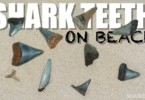Sharks are fascinating creatures as they have survived through millions of years of progression to become the apex predators that they are at present. It is no shock that they would have the means to harm their prey in order to catch it. While shark bites are not rare, they do happen, but what other means do they have to inflict harm upon their prey? Let’s find out. We’ll discuss how the shark skin is made up of tiny teeth-like structures, and we’ll answer the question; can shark scales cut you?
In this article, we will discuss if sharks can vandalize their prey with the help of their scales. The Great White shark, the tiger shark, and the bull shark are among the most aggressive sharks, but their bites are not the only things dangerous to people. Let’s explore the idea of shark scales, how they are made, and if shark scales can cut you or not.
What is shark skin made of?
Now you may be thinking, what’s the relationship between shark skin and scales? We understand why you would think that since shark skin looks really smooth. It does not look like it would be a rough surface or if there would be little teeth-like structures. When you look at a shark’s skin, it looks like you would be able to move your hand over it smoothly. The reality, however, is quite different. Despite the smooth appearance, shark skin is made up of tiny scales.
The tiny teeth-like scales on the surface of shark skin are known as dermal denticles. If shark skin has denticles, then why is it smooth? The anatomy of shark skin holds the answer. The dermal denticles point towards the tail, i.e., the sharp side of a dermal denticle points towards the tail. When you move your hand on shark skin, it feels smooth, but from head to tail. If you move your hand from the tail of the shark to its head, you will feel a sandpaper-like texture on the skin.
These v-shaped dermal denticles are so closely placed together that there is no space between them. The dermal denticles on a shark’s skin stop growing once they reach the optimum size. So, as the shark grows more and more, the size of the dermal denticles remains the same but their quantity increases. These dermal denticles help the sharks in reducing surface drag and acting as armor against ectoparasites.
Can shark scales cut you?
Now, time for the big question, can you cut yourself when a shark scale hits you? The answer differs with the context. If you intentionally move your hand across the shark’s skin, of course, you won’t move it aggressively. This won’t result in any kind of damage. But then again, that rarely occurs. The point here is that if a shark brushes against you while you are in the water or on a ship, the result can be different. Because the dermal denticles of the shark point towards the end of the tail, it depends.
If a shark brushes against you aggressively while you are swimming or on a ship, you can definitely be injured. This scenario is known as shark skin laceration. There have been multiple cases of shark skin lacerations throughout many years. Still, there is not enough medical literature on shark skin laceration because it rarely ever happens.
A case of a 50-year-old man is documented, who had a shark brush its tail on his leg, which deeply lacerated his leg. The man had a laceration to the level of the subcutis, and the wound completely healed after 12 weeks, still leaving its marks. One week after the attack, the laceration was still deep, with black-colored nonviable tissue being debrided. So, yes, you can definitely get a wound if a shark brushes up against you.
As mentioned before, shark attacks rarely happen. The total number of unprovoked shark attacks in 2021 around the whole world was 73. Still, whenever it happens, sharks often brush up against their victim before biting them.
You can get an idea of how sharp shark skin is by one of its uses. Before sandpaper was invented, shark skin was used as sandpaper. This was known as shagreen, an effective sandpaper-like material used to polish wood and other materials. So it is no wonder that a shark bump can end up in abrasions and lacerations on the body of the victim.
Conclusion
Dermal denticles, also known as placoid scales, can be harmful when aggressively used by the shark. However, looking at the rare incidents of shark attacks yearly throughout the world, we can definitely say that it rarely ever happens. So, if you ever come across shark skin and wonder why it is textured and rough, you will already know the answer!







